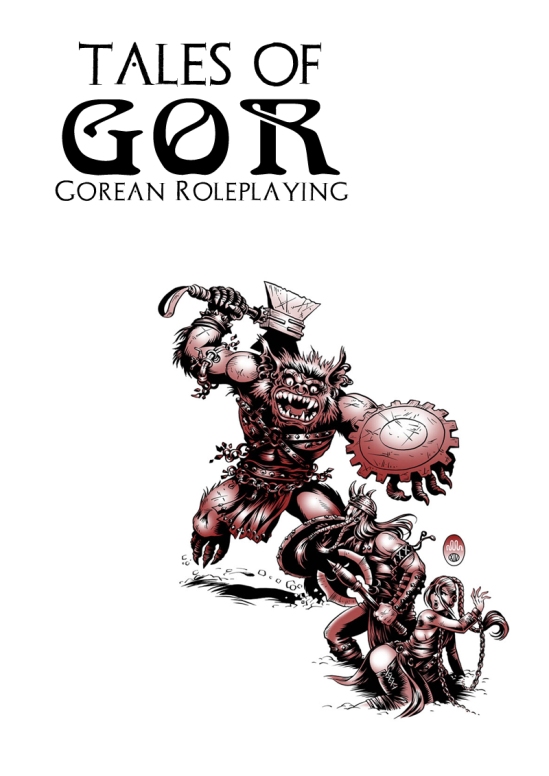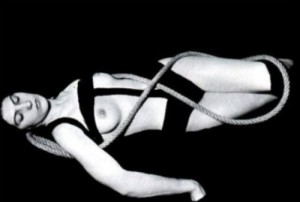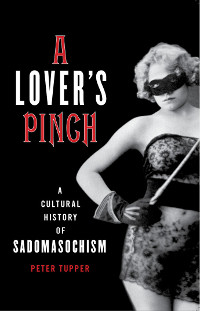Elliot and Ahsley continue their relationship, now into vanilla sex. This scene is fully in the conventions of softcore porn, with soft lighting and rich textiles in Elliot’s bedroom, instead of the hard lighting and concrete walls of his dungeon. He even makes her breakfast the next morning. While it’s competently done, it’s pretty standard, instead of the kink we were promised. I have nothing against romance, but you can get that everywhere.
Episode 3
This episode starts off with another soft-core BDSM scene in Nolan’s dungeon. It’s competently shot, with implied cunnilingus and male butt exposure, but doesn’t go into the characters at all, except for hinting that Dylan is getting jealous of the women she brings to him.
Most of this episode revolves around a party. Borrowing Linda Williams’ observation in Hard Core that sex serves the function in porn that singing and dancing does in musicals, this provides a premise for various subplots and couplings. Such as Elliot getting Ashley in his sights. She fascinates him more than Dylan’s latest acquisition for him, who promises “nothing is off limit”.
Lying somewhere on the boundary between affectionate fetishism and domestic violence, spankings between lovers or would-be lovers were a staple of Hollywood romance movies. Jezebel has a pictorial and essay on the subject, by Andrew Heisel. This was reflected in real-life practices of the time, when husbands were expected to treat their lives like children.

I suppose it was inevitable that, given the prominence of (a version of) BDSM after Fifty Shades and the creative opportunities of the golden age of cable TV, somebody would do a BDSM-themed TV series. To be honest, I went into Showtime’s Submission with low expectations.

Cover mockup of Gorean RPG, showing a hairy humanoid creature about to attack an armed man, with a chained woman behind him
Postmortem Studios is working on a tabletop roleplaying game based on the Gor series of fantasy novels by John Norman (a.k.a. philosophy professor John Lange). Published since the 1960s, Gor is a modern version of the Orientalist fantasies of savage lands and slave markets and so on. You can read about their ongoing project on their blog. Gor has a long history of being recreated in Second Life and other online roleplaying environments, so it’s not surprising that someone would try to adapt it to the tabletop, dice-and-paper form of roleplaying.
I learned about this from following the Facebook page of Michael Manning, my favourite (living) fetish/BDSM artist. He’s illustrating the entire book. Manning is primarily known as a fetish/BDSM artist, and it makes sense that he would be tapped for this project. Apart from the standard ferocious monsters, sword-wielding warriors, decadent cities and savage fighting, the books are rife with BDSM imagery. So much so, that there is a fringe subset of the BDSM culture based on the books, Goreans, who borrow the iconography and terminology of the books, such as slave positions and so on. Some of these terms have seeped out into the broader BDSM world.
Gor is notorious for its strong emphasis not only on the world’s apparently universal chattel slavery, but the male-dominant/female-submissive philosophy that justifies it, endlessly reiterated in the books. That’s what made me pause when I thought about Manning illustrating the book. Manning’s work, starting with the graphic novel The Spider Garden, has a strong bi/queer flair, running all over the map of sexuality from conventional, heteronormative pinups to “sacred androgynes”, cross-dressed men, and other, stranger types of sexuality. This also comes in a time when video games and related media like tabletop RPGs are under a lot of flak for #GamerGate. The games designer, James Desborough, reportedly has connections to #GamerGate and some other controversies. It got me wondering: how will Gor be adapted into this medium?
Berlatsky, Noah. 2015. Wonder Woman: bondage and feminism in the Marston/Peter Comics, 1941-1948. New Brunswick, New Jersey : Rutgers University Press

Wonder Woman spanking a man in Roman soldier uniform
Growing up, I had the notion that Wonder Woman had been created in the past as a perfect feminist icon, and only later was the character sexualized by other creators. In fact, Wonder Woman was “always, already” as much a figure of fetishistic fantasy as she was a feminist role model, patriotic symbol, or heroine for children. The original seven-year run of comics, written or co-written by William Moulton Marston and illustrated by William Peter displayed the kind of deep psychosexual weirdness usually only found in 19th century children’s books. (I say that as a fan of deep psychosexual weirdness.) Noah Berlatsky’s book explores just how queer and feminist those stories were; as the author puts it, “a flamboyantly gendered mess.”[Pg.169] Continue reading »

My apologies for addressing the film adaptation of Fifty Shades of Grey so late. I obtained one copy of the film through admittedly dubious means (let’s just say the text messages are in Spanish), and another in which the subtitles were in originally in, I think, Thai, then covered up by another layer of subtitles in Spanish, and all the explicit sex was cut.
Beyond all that, I could only watch about five minutes at a time. Somebody asked me how I got through the film and I joked, “I kept a fifth of Scotch handy.”

As of this writing, Fifty Shades of Grey holds a 32% rating on Rotten Tomatoes, a 47 on MetaCritic, and a 3.1 on IMDB. Suffice to say, it won’t sweep the Oscars next year. I do predict it will do well at the Golden Raspberries. Its loyal fanbase will probably guarantee a commercially successful opening weekend and a lot of DVD sales, but I suspect it will do poorly in the long run.
I am a little disappointed we won’t see little CGI chibi versions of Dakota Johnson’s subconscious and inner goddess hopping around.
Mileaf, Janine. Please Touch: Dada & Surrealist Objects After The Readymade. Dartmouth College Press, 2010
As I’ve observed before, there’s a relative lacuna in BDSM history, between the Victorians and the post-WWII era. The first half of the 20th century is relatively undocumented, though I have found a few exceptions.
Artist and photographer Man Ray made several sadomasochistic photos in his career in the 1920s and 1930s. He was also a devotee of the works of the Marquis de Sade, and made portraits of the Marquis. Man Ray was one of many artists of the time interested in “the primitive”, taking inspiration from aboriginal people around the world, and seeking truth through extreme mental and physical states.



